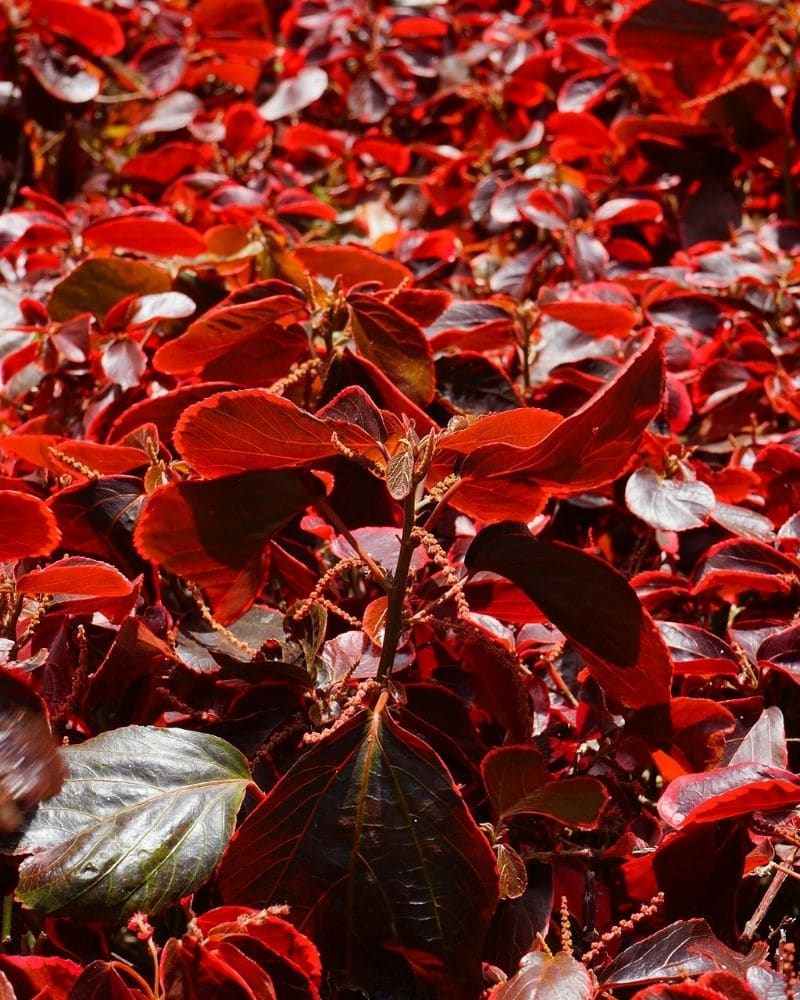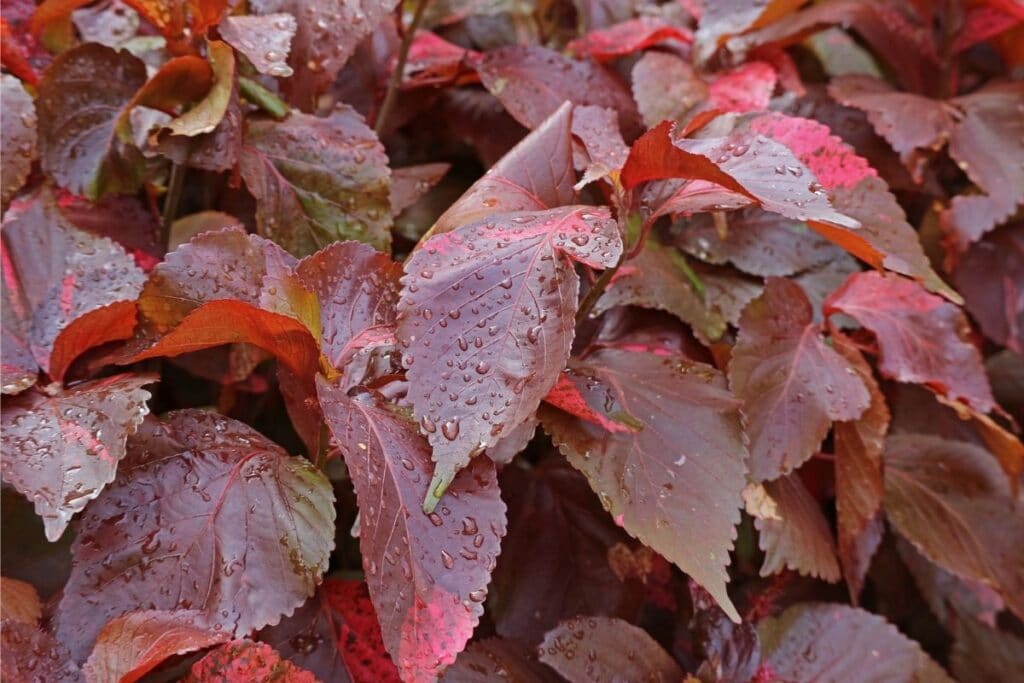Acalyphas are attractive warm-climate evergreens that have either spectacular warm-colored foliage or bold pendulous crimson flowers.
Two species are popular garden plants and they both have very similar care and growth requirements, so we’ll cover them both in this guide to growing and caring for acalyphas.
What Is Acalypha?
Acalypha, pronounced ack-uh-life-uh, is a genus of flowering plants from the Euphorbiaceae family. Acalypha wilkesiana and A. hispida are tropical evergreen shrubs that provide bold colors and textures to gardens in warm, humid climates.
The first species is commonly known as copperleaf or Jacob’s coat but is also sometimes called the copperleaf, lance copperleaf, or copper plant. A. hispida is called the chenille plant, monkey’s tail, red-hot cat’s tail, fox’s tail, or the Philippines medusa.

These showy broadleaf evergreens are native to the South Pacific islands and Southeast Asia, where they grow in warm, tropical and subtropical regions, as well as humid habitats.
The copperleaf plant grows to about 4 ft (1.2 m) high and 3 ft (0.9 m) across but can reach nearly 10 ft (3 m) tall and 6.5 ft (2 m) across. The chenille plant is usually a little larger at 4 to 6 ft (1.2 to 1.8 m) tall and 6 to 8 ft (1.8 to 2.4 m) across.
Acalyphas have simple, alternately arranged leaves that are 4 to 8 inches (10 to 20 cm) long and heart-shaped. The multicolored leaves of the copperleaf plant grow in combinations of red, pink, copper, orange, yellow, white, green, and purple.
The leaves of both species have serrated margins.
Acalypha Flowers
Copperleafs are better known for their showy foliage than their greenish-colored flowers which are produced throughout the year. Copperleaf plants have male and female flowers on the same plant.
The chenille plant, on the other hand, produces very showy and interesting crimson flowers. Each individual flower on its own is rather insignificant but in the long, pendulous inflorescences this copper leaf plant is so popular for, the effect is striking.
This species has separate male and female individuals, and it’s really only the female plants that interest us, as the male flowers are not very showy.
How To Grow an Acalypha Shrub
You can grow acalyphas from softwood cuttings in early spring or from semi-hardwood cuttings taken in late summer. Treat these cuttings with root hormone powder for the best results.
These plants should be grown in fertile and well-drained soil but kept moist as neither species is very drought tolerant. These indoor plants will benefit from regular watering in the growing season but will not need much water in the cooler months, provided you don’t let the soil dry out.
The soil itself can be clay, sand, or loam-based and a variety of soil pHs are acceptable, but heavier soils will benefit from the addition of some organic nutrients.
Grow your acalypha evergreen shrub in full sun for the best results. These plants can be grown in partially shaded areas, but unfortunately, they won’t flower as well or develop the beautiful variegated leaves of plants grown in direct sunlight locations.
Being tropical species, acalypha plants do not tolerate frost and will suffer in temperatures below 50 °F (10 °C). Grow these plants in USDA Hardiness zones 10 to 12 and try to plant them in an area that is sheltered from strong winds.
Care and Maintenance
Although acalyphas are considered low-maintenance plants, they are fast-growing, and you’ll probably want to prune these plants to achieve a denser growth form. Deadheading the spent flowers of the chenille plant before they completely die off will stimulate vigorous new flower growth.
Chenille plants may also benefit from severe pruning in the spring, down to around 8inches (20 cm) above the ground, to stimulate vigorous new growth and flowering.
These plants benefit from rich soils, and when grown in containers, in particular, will benefit from the monthly addition of liquid fertilizer in the growing season.
Acalyphas are pretty pest resistant, but they are sometimes affected by spider mites, whiteflies, and mealybugs. Other pests like scale and aphids could also affect this plant, especially if grown in partial shade. (2)
Uses
The copperleaf makes a wonderful accent hedge or specimen. Care should be taken not over-plant this species though because it really does have a bold look, wherever it is planted. (1)
In colder climates, these plants can be grown as annuals, or as house plants, or container plants that are brought inside in cold periods.
The chenille plant has all the same uses as the copperleaf but is also especially attractive in hanging containers.
Other Acalypha Species
Dwarf chenille (Acalypha reptans) is another attractive evergreen shrub. This smaller species grows to just 18 inches (45 cm) tall and produces beautiful red flower spikes up to 3 inches (7.5 cm) long.
This plant has much the same care requirements as the other copperleaf plant varieties but has the benefit of being a native species, occurring naturally in Florida and the Caribbean.
This species makes an excellent house plant or container plant, especially if grown in hanging pots.
FAQs
Is Acalypha an indoor plant?
No, Acalypha is primarily grown as an outdoor plant in warm temperatures. However, it can be brought indoors as a houseplant in suitable conditions, such as indirect bright light and well-draining soil.
What is the lifespan of Acalypha?
The lifespan of Acalypha can vary depending on growing conditions, species, and care. With proper care, it can live for several years, providing colorful foliage and flowers in suitable tropical climates.
What are the benefits of Acalypha plant?
Acalypha plants are valued for their attractive foliage and colorful blooms, which can add visual interest to gardens and landscapes. Some species also have medicinal uses in traditional medicine. Additionally, Acalypha is perfect for hanging baskets, where its pendulous fuzzy red tassels create a striking display.
Is Acalypha a herb or shrub?
Acalypha includes various species, some of which are herbs and others that are shrubs. Commonly grown species, such as Acalypha wilkesiana, are typically cultivated as shrubs due to their larger size and woody stems.
Conclusion
Acalyphas are striking and easy to care for evergreens that could work wonders in your yard, or on your patio or sunny windowsill. Their versatility and their ability to grow fast and survive as annuals in cooler climates make them a great choice for your garden.
*image by shinylion/depositphotos
References
Reference List:
(1) Gilman, E. F. Klein, R. & Hansen, G. Acalypha amentacea subsp. wilkesiana: Copperleaf https://edis.ifas.ufl.edu/pdffiles/FP/FP00600.pdf
(2) Gilman, E. F. Klein, R. & Hansen, G. Acalypha hispida: Chenille Plant https://edis.ifas.ufl.edu/pdffiles/FP/FP00400.pdf
Close







